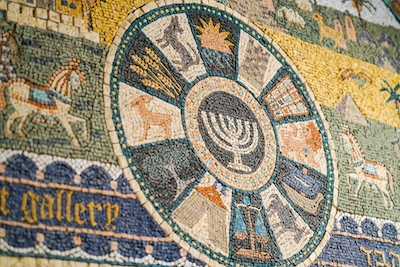In a mishnah back on Sanhedrin 60, we learned that someone who defecates before the idol known as Ba’al Peor, or who throws a stone at Mercury, is liable for the death penalty. In most contexts, defecation and stone throwing are signs of disrespect. But according to the mishnah, in these specific cases they are considered to be the proper form of worship. So if a Jewish person were to act in such a way, they are guilty of idol worship and subject to the death penalty.
On today’s daf, the Gemara relates the following story:
Rav Menashe was going to Bei Torta. The people there said to him: There is idol worship here. Rav Menashe picked up a stone and threw it at the idol. They said to him: It is Mercury.
The people of Bei Torta bring Rav Menashe’s attention to an idol in their midst. As a sign of disrespect, or maybe even in an attempt to destroy it, he throws a stone at the statue, only to learn afterward that the idol was Mercury. The townsfolk may have been a bit nervous that this action constituted idol worship, which would have cost Rav Menashe his life, but he is not so worried, explaining:
We learned that one who throws a stone at Mercury (as a manner of worship is liable, whereas I intended to demean it).
It is not the act itself that makes something idol worship, claims Rav Menashe, but rather the intention of the actor. True, the mishnah prohibits throwing stones at a statue of Mercury. But by Rav Menashe’s reading, this prohibition applies only when the stone is thrown for ritual purposes. Since his actions were meant to demean the statue, he has not performed an act of idol worship.
But something about the incident in Bei Torta did not sit well with Rav Menashe, who goes to the study hall to confirm that he is in the clear. Alas, he does not get the result he is looking for.
They said to him: We learned one who throws a stone at Mercury (is liable), even if he intends to stone it.
The sages understand the mishnah’s prohibition against throwing stones at Mercury to be absolute, regardless of whether one intended to worship Mercury or demean it. In an attempt to rectify the matter, Rav Menashe tells the sages that he’ll reverse his actions by going back to Bei Torta to remove the stone he threw. But this is not sufficient, as removing the stone merely makes room for someone else to add another one to the pile, thereby abetting a separate act of idol worship.
Since the majority opinion of the sages outweighs Rav Menashe’s minority view, he is indeed guilty of idol worship, but his life is not in danger. As Tractate Sanhedrin has made clear, in order for a person to be put to death, forewarning is required. Since the people did not let Rav Menashe know that the statue was Mercury before he threw the rock, there was no way for him to know he would be subject to the death penalty for doing so. As an unwitting offender, he is on the hook only for a sacrifice.
Read all of Sanhedrin 64 on Sefaria.
This piece originally appeared in a My Jewish Learning Daf Yomi email newsletter sent on February 19, 2025. If you are interested in receiving the newsletter, sign up here.

Help us keep Jewish knowledge accessible to millions of people around the world.
Your donation to My Jewish Learning fuels endless journeys of Jewish discovery. With your help, My Jewish Learning can continue to provide nonstop opportunities for learning, connection and growth.



